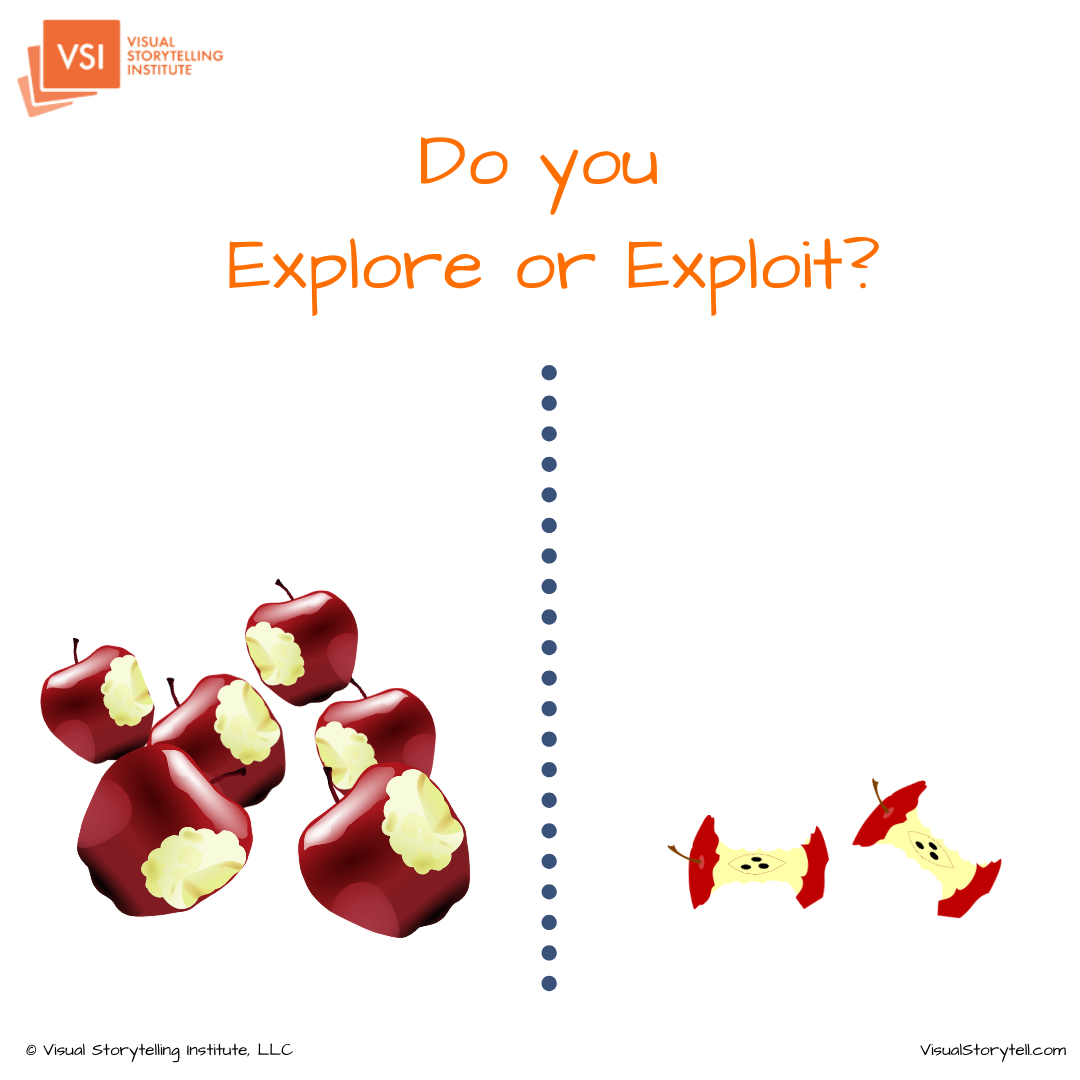
Explore vs. Exploit in Storytelling
Explore vs. Exploit in Storytelling https://www.visualstorytell.com/wp-content/uploads/2020/12/explore-vs.-exploit_thumb.png 366 222 Shlomi Ron Shlomi Ron https://secure.gravatar.com/avatar/995c0cf093380b90c7704fda398c9addf4e5c605afbc92af5c3f01f67d65aa41?s=96&d=mm&r=g- Shlomi Ron
- no comments
As this wild year is nearing its end, movies have been an important outlet for all of us to escape and unwind in story land.
The US market for streaming services has grown by 37% in 2020, with most of the growth coming from Disney+ which made it the third largest streaming service in the United States (no wonder, it’s parents’ new “Digital Pacifier,”) behind only Netflix and Hulu (Antenna Analytics).
No doubt the streaming services category is another perfectly aligned winner during the pandemic.
With such success it made me wonder. How do you select what movie to watch on your streaming service?
Do you Explore or Exploit?
Since our modern campfire for consuming stories has become Netflix and its equivalents, do you try many films for a few minutes before your final selection (Explore)?
Or do you only pick movies based on your prior preference for the director/actor/topic and watch them in full (Exploit)?
My choice is further down.
 True, social media algorithms are also coded to exploit and explore what you see on your feed to maximize viewership and ad dollars.
True, social media algorithms are also coded to exploit and explore what you see on your feed to maximize viewership and ad dollars.
Unfortunately, along with permissive regulations, misinformation and disinformation have gone out of control.
On streaming services, that’s how algorithms control our film’s feed based on our past watching habits and a few related bets that can bias our pull of options.
But ultimately your decision behavior shapes your experience.
You either end up spending half an hour sampling options (explore) or deep into the first act of the story your best friend has recommended (exploit).
I confess, I’m generally the Explorer type that browses featured and categorized options.
I’ll exploit if I come across a hyped up movie like The Social Dilemma or by director, or actors I like.
Or often, I take the middle road, and use the search box to look for topics (e.g., time travel), titles or geographical regions and languages.
The Explore/Exploit dilemma – also referred to as the Multi-Armed Bandit Problem – is used in Reinforcement Learning which is part of machine learning and for studying decision making behaviors. And in fact you’ll find it affecting every aspect of your life; from choosing a restaurant, a book, a spouse and yes, when running A/B testing your holiday special banners.
As human beings, we’re constantly seeking meanings by making exploring choices around us and then exploiting or optimizing the better-performing option.
Think about it the next time you not only pick what movie to watch but also in your visual storytelling strategy.
No wonder the explore/exploit dilemma also affects our visual storytelling strategy.
Think of it impacting two levels:
The storyteller: How do you present your stories on your own Website and social media profiles? How much do you experiment new stories vs. exploiting stories have been worked in the past? This area also relates to content personalization of Websites. There is a whole category of personalization platforms that allows you to set a business rule of how much exploration vs. exploitation you’d like to focus on.
The Story Consumer: Here you want to uncover what is your actual customer behavior you want to exploit/optimize against your target KPIs (e.g., reach, engagement, sales, etc.) . Are there any dominant behavior patterns? Distinct preferences for story types, story structures, story lengths, visual media formats on which platforms, at which buying stage?
As you can see, the exploring part comes with an opportunity cost. The wider net you cast testing a large number of story options, you’ll learn a lot but with higher probability of losing traction. If you limit your test universe to a smaller amount of story options than you optimize performance with a minimal loss.
The key message is that you want to constantly allocate a small percentage of your visual storytelling strategy to exploration where you test new story types based on insights from your ongoing research of your audience, competition and your industry.
Why? The market is constantly evolving outside of your control. Your best bet is to listen, catch these changes and timely respond.
Need help optimizing your team’s visual storytelling strategy to meet your audience’s changing needs and priorities? Feel free to schedule a conversation!
- Post Tags:
- explore vs. exploit
- personalization
- Posted In:
- Story Making
- Story Visualizing
- Visual Storytelling
Shlomi Ron
Shlomi Ron is the founder and CEO of the Visual Storytelling Institute, a Miami-based think tank with a mission to bring the gospel of visual storytelling from the world of art to more human-centric and purpose-driven marketing. A digital marketing veteran with over 20 years of experience working both on the agency and brand sides for Fortune 100/500 brands such as Nokia, IBM, and American Express. He started VSI to combine his marketing expertise with his passion for visual stories stemming from his interests in classic Italian cinema and managing the estate of video art pioneer, Buky Schwartz. At VSI, he helps brands rise above the communication noise through visual storytelling consulting, training, and thought leadership. Select clients include Estée Lauder, Microsoft, and Cable & Wireless – to name a few. He currently teaches Brand Storytelling at the University of Miami’s Business School. Thought leader and speaker at key marketing conferences. He is also the host of the Visual Storytelling Today podcast, which ranks in the top 10 best business storytelling podcasts on the Web. His book: Total Acuity: Tales with Marketing Morals to Help You Create Richer Visual Brand Stories. Outside work, he is a nascent bread baker, The Moth fan, and longtime fedora wearer likely to jive with his classic Italian cinema interest.
All stories by: Shlomi RonThis site uses Akismet to reduce spam. Learn how your comment data is processed.


Leave a Reply